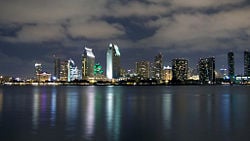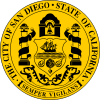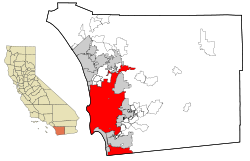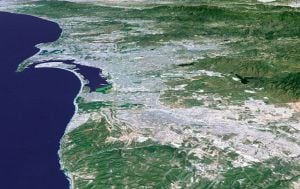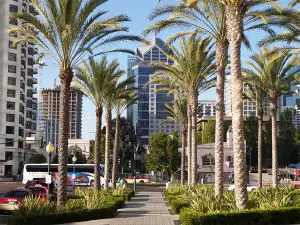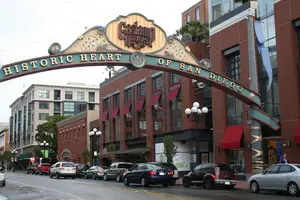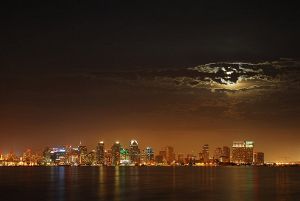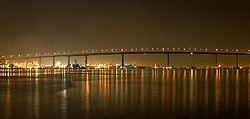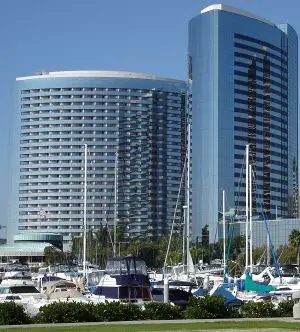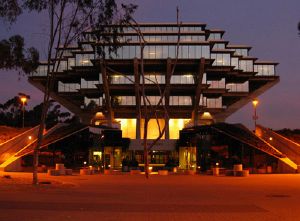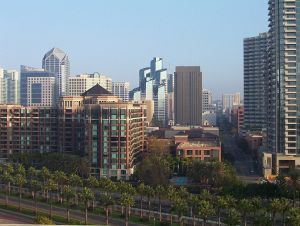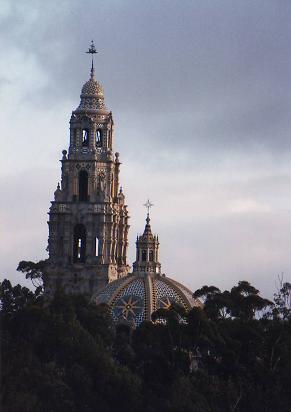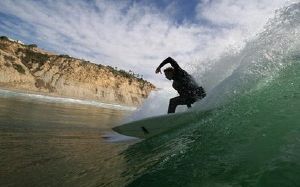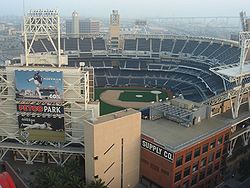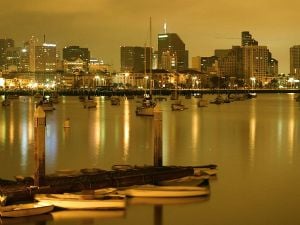San Diego, California
| City of San Diego | |||||||||||
| San Diego Skyline | |||||||||||
|
|||||||||||
| Nickname: America's Finest City | |||||||||||
| Motto: Semper Vigilans (Latin for Ever Vigilant) | |||||||||||
| Location of San Diego within San Diego County |
|||||||||||
| Country | United States | ||||||||||
|---|---|---|---|---|---|---|---|---|---|---|---|
| State | California | ||||||||||
| County | San Diego | ||||||||||
| Founded | July 16, 1769 | ||||||||||
| Incorporated | March 27, 1850 | ||||||||||
| Government | |||||||||||
| - Type | Mayor-council | ||||||||||
| - Mayor | Jerry Sanders (R) | ||||||||||
| - City Attorney | Michael Aguirre | ||||||||||
| - City Council | Scott Peters Kevin Faulconer Toni Atkins Tony Young Brian Maienschein Donna Frye Jim Madaffer Ben Hueso |
||||||||||
| Area | |||||||||||
| - City | 372.1 sq mi (963.6 km²) | ||||||||||
| - Land | 324.3 sq mi (840.0 km²) | ||||||||||
| - Water | 47.7 sq mi (123.5 km²) | ||||||||||
| Elevation | 72 ft (22 m) | ||||||||||
| Population (2007)[1] | |||||||||||
| - City | 1,266,731 | ||||||||||
| - Density | 3,871.5/sq mi (1,494.7/km²) | ||||||||||
| - Metro | 2,941,454 Including Tijuana: 4,922,723 |
||||||||||
| - Ranked | 8th | ||||||||||
| Time zone | PST (UTC-8) | ||||||||||
| - Summer (DST) | PDT (UTC-7) | ||||||||||
| ZIP code | 92101-92117, 92119-92124, 92126-92140, 92142, 92145, 92147, 92149-92155, 92158-92172, 92174-92177, 92179, 92182, 92184, 92186, 92187, 92190-92199 | ||||||||||
| Area code(s) | 619, 858 | ||||||||||
| FIPS code | 06-66000 | ||||||||||
| GNIS feature ID | 1661377 | ||||||||||
|
|||||||||||
| Website: http://www.sandiego.gov/ | |||||||||||
San Diego is a large coastal Southern California city located in the southwestern corner of the continental United States. In 2007, the city's population was estimated to be 1,266,731.[1] It is the second largest city in California and the eighth largest city in the United States, by population. It is the county seat of San Diego CountyGR6 and is the economic center of the San Diego–Carlsbad–San Marcos metropolitan area, the 17th-largest in the United States with a population of 3,146,274 as of 2008, and the 21st-largest metropolitan area in the Americas when including Tijuana.
San Diego County lies just north of the Mexican border—sharing a border with Tijuana—and lies south of Orange County. It is home to miles of beaches and has a mild Mediterranean climate and 16 military facilities hosting the United States Navy, the United States Coast Guard,m and the United States Marine Corps.
The presence of the University of California, San Diego (UCSD) with the affiliated UCSD Medical Center promotes research in biotechnology. San Diego's economy is largely composed of agriculture, biotechnology/biosciences, computer sciences, electronics manufacturing, defense-related manufacturing, financial and business services, ship repair and construction, software development, telecommunications, and tourism.
Geography
The city of San Diego has deep canyons separating its mesas, creating small pockets of natural parkland scattered throughout the city. The same canyons give parts of the city a highly segmented feel, creating literal gaps between otherwise proximal neighborhoods and contributing to a low-density, car-centered environment. Downtown San Diego is located on San Diego Bay. Balboa Park lies on a mesa to the northeast. It is surrounded by several dense urban communities and abruptly ends in Hillcrest to the north.
The Coronado and Point Loma peninsulas separate San Diego Bay from the ocean. Ocean Beach is on the west side of Point Loma. Mission Beach and Pacific Beach lie between the ocean and Mission Bay, a man-made aquatic park. La Jolla, an affluent community, lies north of Pacific Beach. Mountains rise to the east of the city, and beyond the mountains are desert areas. Cleveland National Forest is a half-hour drive from downtown San Diego. Numerous farms are found in the valleys northeast and southeast of the city.
San Diego County has one of the highest counts of animal and plant species that appear on the endangered species list among counties in the United States.
Climate
San Diego has a Mediterranean, or semi-arid, climate. San Diego enjoys mild, mostly dry and plenty of sunshine throughout the year with 264 sunshine days annually.[2] Temperatures vary little throughout the year. Summer or dry period of May to October are mild to warm with average high temperatures of 70-78°F (21-26°C) and lows of 55-66°F (13-19°C), and temperatures only exceed 90°F (32°C) four days a year. Winters, or the rainy period of November to April, are mild and somewhat rainy with high temperatures of 66-70°F (19-21°C) and lows of 50-56°F (10-13°C).
Climate in the San Diego area and the rest of California often varies dramatically over short geographical distances, due to the city's topography (the Bay, and the numerous hills, mountains, and canyons). Particularly during the "May gray / June gloom" period, a thick "marine layer" cloud cover will keep the air cool and damp within a few miles of the coast, but will yield to bright cloudless sunshine between about 5 and 15 miles (9-24 km) inland—the cities of El Cajon and Santee for example, rarely experience the cloud cover. This phenomenon is known as a microclimate.
Rainfall averages about 10 inches (251 mm) of precipitation annually, mainly during the cooler months of December through April.
Ecology
Like most of southern California, the majority of San Diego's current area was originally occupied by chaparral, a plant community made up mostly of drought-resistant shrubs. The endangered Torrey pine has the bulk of its population in San Diego in a stretch of protected chapparral along the coast.
The steep, varied topography and proximity to the ocean create a number of different habitats within the city limits, including tidal marsh and canyons. The influence of humans has altered existing habitats and has also created habitats that did not exist prior to human development, by construction of buildings, the introduction of new species, and the use of water for lawns and gardens. A number of species of parrots, including the Red-masked Parakeet and Red-crowned Amazon, have established feral populations in urban neighborhoods such as Ocean Beach.
San Diego's broad city limits encompass a number of large nature preserves, including Torrey Pines State Reserve, Border Field State Park, Mission Trails Regional Park. Torrey Pines State Preserve, and a coastal strip continuing to the north is the only location where the rare species of Torrey Pine, P. torreyana torreyana, is found. Due to a combination of the steep topography that prevents or discourages building, and some efforts for preservation, there are also a large number of canyons within the city limits that are nature preserves, including Tecolote Canyon Natural Park and Marian Bear Memorial Park in the San Clemente Canyon, as well as a number of small parks and preserves.
Fire
The chaparral and coastal sage scrub habitats in low elevations along the coast are prone to wildfire, and the rates of fire have increased in the 20th century, due primarily to fires starting near the borders of urban and wild areas. In 2003, San Diego was the site of what has been called the largest wildfire in California over the past century. In addition to damage caused by the fire, smoke from the fire resulted in a significant increase in emergency room visits due to asthma, respiratory problems, eye irritation, and smoke inhalation.
History
The area has long been inhabited by the Kumeyaay people. The first European to visit the region was Portuguese explorer Juan Rodrigues Cabrillo, sailing under the Spanish flag, who claimed the bay for the Spanish Empire.
In November 1602, Sebastián Vizcaíno was sent to map the California coast. Vizcaíno surveyed the harbor and what are now Mission Bay and Point Loma and named the area for the Catholic Saint Didacus, a Spaniard more commonly known as "San Diego."
In 1769, Gaspar de Portolà established the Presidio of San Diego (a military post) overlooking Old Town. Around the same time, Mission San Diego de Alcalá was founded by Franciscan friars under Father Junípero Serra. By 1797, the mission boasted the largest native population in Alta California, with over 1,400 neophytes living in and around the mission.
After New Spain won its independence from the Spanish Empire, the mission's fortunes declined with the decree of secularization, as was the case with all of the missions under the control of Mexico.
The end of the Mexican-American War and the California Gold Rush of 1848 drew a wave of settlers. San Diego was designated the seat of the newly established San Diego County and was incorporated as a city in 1850.
A significant U.S. naval presence began in 1907 with the establishment of the Navy Coaling Station, which gave further impetus to the town's development. San Diego hosted two World's Fairs, the Panama-California Exposition in 1915, and the California Pacific International Exposition in 1935.
After World War II, the military played an increasing role in the local economy, but post-Cold War cutbacks took a heavy toll on the local defense and aerospace industries. The resulting downturn led San Diego leaders to seek to diversify the city's economy, and San Diego has since become a major center of the emerging biotechnology industry. It is also home to telecommunications giant Qualcomm.
Downtown San Diego has been undergoing an urban renewal since the early 1980s. The Centre City Development Corporation (CCDC), San Diego's downtown redevelopment agency, has transformed what was a largely abandoned area into a glittering showcase of waterfront skyscrapers, five-star hotels, and many cafés, restaurants, and boutiques.
A series of scandals has rocked the city in recent years. Two city council members were convicted of extortion, wire fraud, and conspiracy to commit wire fraud for taking campaign contributions from a strip club owner and his associates, allegedly in exchange for trying to repeal the city's "no touch" laws at strip clubs. Both subsequently resigned. In 2005, U.S. Congressman Randy "Duke" Cunningham resigned over a bribery scandal and is serving a 100-month prison sentence.
Economy
The three largest sectors of San Diego's economy are defense, manufacturing, and tourism respectively.[3]
Several areas of San Diego (in particular La Jolla and surrounding Sorrento Valley areas) are home to offices and research facilities for numerous biotechnology companies. Major biotechnology companies like Neurocrine Biosciences and Nventa Biopharmaceuticals are headquartered in San Diego, while many biotech and pharmaceutical companies, such as BD Biosciences, Biogen Idec, Integrated DNA Technologies, Merck, Pfizer, Élan, Genzyme, Cytovance, Celgene and Vertex, have offices or research facilities in San Diego. There are also several non-profit biotech institutes, such as the Salk Institute for Biological Studies, the Scripps Research Institute and the Burnham Institute. The presence of University of California, San Diego and other research institutions helped fuel biotechnology growth. In June 2004, San Diego was ranked the top biotech cluster in the U.S. by the Milken Institute.[4]
San Diego is home to companies that develop wireless cellular technology. Qualcomm Incorporated was founded and is headquartered in San Diego; Qualcomm is the largest private-sector technology employer (excluding hospitals) in San Diego County.[5] The largest software company in San Diego (according to the San Diego Business Journal) is security software company Websense Inc.[6]
The economy of San Diego is influenced by its port, which includes the only major submarine and shipbuilding yards on the West Coast, as well as the largest naval fleet in the world. The cruise ship industry, which is the second largest in California, generates an estimated $2 million annually from the purchase of food, fuel, supplies, and maintenance services.[7]
Due to San Diego's military influence, major national defense contractors, such as General Atomics and Science Applications International Corporation are headquartered in San Diego.
Tourism is also a major industry owing to the city's climate. Major tourist destinations include Balboa Park, the San Diego Zoo, Seaworld, nearby Wild Animal Park and Legoland, the city's beaches and golf tournaments like the Buick Invitational.
Personal income
In 2000, the median income for a household in the city was $45,733, and the median income for a family was $53,060. Males had a median income of $36,984 versus $31,076 for females. The per capita income for the city was $23,609. About 10.6% of families and 14.6% of the population were below the poverty line, including 20.0% of those under age 18 and 7.6% of those age 65 or over.
Military
Military bases in San Diego include U.S. Navy ports, Marine Corps bases, and Coast Guard stations. One of the Marine Corps' two Recruit Depots is located in San Diego. San Diego is also known as the "birthplace of naval aviation," although Pensacola, Florida makes a rival claim.
San Diego is the site of one of the largest naval fleets in the world, and San Diego has become the largest concentration of Naval facilities in the world due to base reductions at Norfolk, Virginia and retrenchment of the Russian naval base in Vladivostok. Two of the U.S. Navy's Nimitz class supercarriers, (the USS Nimitz and the USS Ronald Reagan), five amphibious assault ships, several Los Angeles-class "fast attack" submarines, the Hospital Ship USNS Mercy, carrier and submarine tenders, destroyers, cruisers, frigates, and many smaller ships are home-ported there. Four Navy vessels have been named USS San Diego in honor of the city.[8]
Military institutions in the San Diego area
Marine Corps institutions in San Diego include Marine Corps Air Station Miramar and Marine Corps Recruit Depot San Diego; north of San Diego is Marine Corps Base Camp Pendleton. The Navy has several institutions in the city, including Naval Base Point Loma, Naval Base San Diego (also known as the 32nd Street Naval Station), Bob Wilson Naval Hospital, and the Space and Naval Warfare Systems Center San Diego. Close by San Diego but within San Diego County is Naval Air Station North Island (which operates Naval Auxiliary Landing Facility San Clemente Island, Silver Strand Training Complex, Outlying Field Imperial Beach) and the Naval Amphibious Base Coronado, which are consolidated into Naval Base Coronado.
Real estate
Prior to 2006, San Diego experienced a dramatic growth of real estate prices, to the extent that the situation was sometimes described as a "housing affordability crisis." Median house prices more than tripled between 1998 and 2007. According to the California Association of Realtors,[9] in May 2007, a median house in San Diego cost $612,370. Growth of real estate prices has not been accompanied by comparable growth of household incomes: housing affordability index (percentage of households that can afford to buy a median-priced house) fell below 20% in early 2000s. San Diego metropolitan area had the second worst median multiple (ratio of median house price to median household income) of all metropolitan areas in the United States. As a consequence, San Diego had experienced negative net migration since 2004, with significant numbers of people moving to Baja California and Riverside county, with many residents commuting daily from Tijuana, Temecula, and Murrieta, to their jobs in San Diego. Others are leaving the state altogether and moving to more affordable regions.[10]
From 2005 to 2007, San Diego experienced a greater than 15% decline in real estate prices, which continued to accelerate into 2008. The two-year drop already experienced is worse than the four-year period between June, 1992, and November, 1996, when the region experienced an 11.8% decline in housing prices.[11] Much of this is blamed on the speculative attitude of investors in the early 2000s, who bought much of the available real estate, hoping to "flip" it for a large profit shortly thereafter, and the availability of "stated income" and other "exotic" loans available. When the decline hit, and adjustable-rate mortgages (ARMs) adjusted, many investors simply abandoned their properties, and areas that recently experienced double-digit annual increases in property value, such as San Diego, Los Angeles, Miami and Las Vegas are being hit the hardest.[12]
In the first quarter of 2008, the number of foreclosures repossessed by banks exceeded the number of home sales.[13]
Education
Primary and secondary schools
The San Diego Unified School District, also known as San Diego City Schools, serves the majority of the city. It includes 113 elementary schools, 23 middle schools, 4 atypical schools, 10 alternative schools, 27 high schools, and 25 charter schools. In the northern part of the county, Poway Unified School District and San Dieguito Union High School District are outside city limits but serve several schools within city limits. In the southern part of the county, Sweetwater Union High School District serves multiple schools within city limits, although it is headquartered outside city limits.
San Ysidro School District (K-8) serves areas of San Diego also served by Sweetwater Union High School District. Del Mar Union Elementary School District and Solana Beach Elementary School District serve areas of San Diego also within San Dieguito.
Colleges and universities
Public colleges and universities in the city include University of California, San Diego (UCSD), San Diego State University (SDSU), and the San Diego Community College District, which includes San Diego City College, San Diego Mesa College, and San Diego Miramar College.
Private colleges and universities in the city include Alliant International University (AIU), Coleman University, Design Institute of San Diego (DISD), John Paul the Great Catholic University, National University, NewSchool of Architecture and Design, Pacific Oaks College, The Art Institute of California, San Diego, Point Loma Nazarene University (PLNU), San Diego Christian College, Southern States University (SSU), Woodbury University School of Architecture's satellite campus, and University of San Diego (USD).
There is one medical school in the city, the UCSD School of Medicine. There are three ABA accredited law schools in the city, which include California Western School of Law, Thomas Jefferson School of Law, and University of San Diego School of Law.
Politics
In August 2007, registered Democrats outnumbered Republicans by about 7 to 6. Despite the edge in voter registration for Democrats, the current mayor, Jerry Sanders, is a Republican. San Diego has not elected a Democratic mayor since 1988. Democrats hold a 5-3 majority on the city council, including the current Council President, Scott Peters, a Democrat who often sides with the mayor. 55% of the city of San Diego voted for Democrat John Kerry in the 2004 presidential election. However, the mayor, city council members and city attorney seats are all officially non-partisan.
On September 18, 2007, the City Council with support from Mayor Sanders, voted 5-3 to endorse a pending lawsuit before the California Supreme Court to overturn Proposition 22, which banned same-sex marriage in California. Proposition 22 was supported by 62 percent of San Diego voters.
Proposition 22 was later ruled unconstitutional by the California Supreme Court, but in 2008 California voted to change the California constitution. The proposition received over 50 percent of the votes.
Demographics
As of the censusGR2 of 2000, there were 1,223,400 people, 450,691 households, and 271,315 families residing in the city. The population density was 3,771.9 people per square mile (1,456.4/km²).
There were 451,126 households out of which 30.2% had children under the age of 18 living with them, 44.6% were married couples living together, 11.4% had a female householder with no husband present, and 39.8% were non-families. 28.0% of all households were made up of individuals and 7.4% had someone living alone who was 65 years of age or older. The average household size was 2.61 and the average family size was 3.30.
In the city the population was spread out with 24.0% under the age of 18, 12.4% from 18 to 24, 34.0% from 25 to 44, 19.1% from 45 to 64, and 10.5% who were 65 years of age or older. The median age was 32 years. For every 100 females there were 101.7 males. For every 100 females age 18 and over, there were 100.4 males.
Ancestry/heritage
Population by race/ethnicity (Census 2000 def.).[14][15]
- White Non-Hispanic (49.3%)
- Hispanic/Latino of any race (25.4%)
- Asian (13.6%)
- Black/African American (7.6%)
- Two or more races (3.1%)
- Hawaiian and Pacific Islander alone (0.4%)
- American Indian/Alaska Native alone (0.4%)
- Other Race alone (0.2%)
As of 2000, the place of origin for the Hispanic population was Mexican (83.4%), Puerto Rican (1.9%), Spanish (1.8%) and Cuban (0.6%).[16]
San Diego has the lowest percentage of Hispanics for any city adjacent to the United States-Mexico border.[17][18]
Current estimates
More current estimate of the population as of January 2007 was above 1.3 million. The San Diego Association of Governments estimated the median household income and population as of January 1, 2006, had increased from the year 2000. The population of San Diego was estimated to be 1,311,162, up 7.2% from 2000, and median household income was estimated to be $47,816 (when adjusted for inflation in 1999 dollars), up 5.9% from 2000.[17] According to the U.S. Census 2004 American Community Survey, San Diego city had the fifth largest median household income of places with a population of 250,000 or more.[19]
Crime
Until 2007 San Diego had a declining crime rate from 1990 to 1994, when the city had averaged 139 murders (or 12.2 murders per 100,000 residents).[20][21][22] In 2004, San Diego had the sixth lowest crime rate of any U.S. city with over half a million residents.[22] From 2002 to 2006, violent crime decreased 12.4% while overall crime decreased only 0.8% partly due to a 1.1% increase in property crime.
In 2007 the city had 59 murders and the murder rate rose to 4.7 per 100,000 (national average of 3.1). The overall crime rate rose by 2.1%.[23][24]
Total property crimes were lower than the national average in 2004. In 2007 burglaries, property crime, larceny/thefts, and vehicle thefts were more than twice as high as the national average.
Culture
Many popular museums, such as the San Diego Museum of Art, the San Diego Natural History Museum, the San Diego Museum of Man, and the Museum of Photographic Arts are located in Balboa Park. The Museum of Contemporary Art San Diego (MCASD) is located in an oceanfront building in La Jolla and has a branch located at the Santa Fe Depot downtown. The Columbia district downtown is home to historic ship exhibits as well as the San Diego Aircraft Carrier Museum featuring the USS Midway aircraft carrier.
San Diego has a growing art scene. "Kettner Nights" at the Art and Design District in Little Italy has art and design exhibitions throughout many retail design stores and galleries on selected Friday nights. "Ray at Night" at North Park hosts a variety of small-scale art galleries on the second Saturday evening of each month. La Jolla and nearby Solana Beach also have a variety of art galleries.
The San Diego Symphony at Symphony Towers performs on a regular basis and is directed by Jahja Ling. The San Diego Opera at Civic Center Plaza was ranked by Opera America as one of the top 10 opera companies in the United States. Old Globe Theatre at Balboa Park produces about 15 plays and musicals annually. The La Jolla Playhouse at UCSD is directed by Christopher Ashley. The Joan B. Kroc Theatre at Kroc Center's Performing Arts Center is a 600-seat state-of-the-art theater that hosts music, dance. and theater performances. The San Diego Repertory Theatre at the Lyceum Theatres in Horton Plaza produces a variety of plays and musicals. Serving the northeastern part of San Diego is the California Center for the Arts in Escondido, a 400-seat performing arts theater.
Tourism has affected the city's culture, as San Diego houses many tourist attractions, such as SeaWorld San Diego, Belmont amusement park, San Diego Zoo, San Diego Wild Animal Park, and nearby Legoland. San Diego's Spanish influence can be seen in the many historic sites across the city, such as the Spanish missions and Balboa Park. Cuisine in San Diego is diverse, and there is an abundance of wood fired California-style pizzas, and Mexican and East Asian cuisine. Annual events in San Diego include Comic-Con, San Diego/Del Mar Fair, and Street Scene Music Festival.
San Diego has a large gay culture.[citation needed] The annual Gay Pride Parade drew crowds in excess of 100,000 people in 2007.
San Diego has attracted those who are part of the surf and skateboard culture. Businesses catering to this culture have their headquarters here.
Sports
San Diego has several sports venues: Qualcomm Stadium is the home of the NFL's San Diego Chargers. It also hosts international soccer games. Three NFL Super Bowl championships and many college football bowl games have been held there. Balboa Stadium, the city's first stadium, hosts soccer, American football and track and field.
PETCO Park in downtown San Diego is the home of Major League Baseball's San Diego Padres. Other than baseball, PETCO Park hosts soccer and rugby events. The San Diego Sports Arena hosts basketball, and has also hosted ice hockey, indoor soccer and boxing.
San Diego has the dubious distinction of being the largest United States city to have not won a Super Bowl, World Series, Stanley Cup, NBA Finals or any other major league sports championship; this is known as the San Diego Sports Curse.
Media
San Diego is served by The San Diego Daily Transcript, as well as the mainstream daily newspaper, The San Diego Union-Tribune and its online portal, signonsandiego.com, the online newspaper Voiceofsandiego.org, and the alternative newsweeklies, the San Diego CityBeat and San Diego Reader. San Diego Magazineis a city regional magazine publication in the county, covering politics, business, fashion, dining and community events. Another newspaper is the North County Times, which serves San Diego's North County area. Business publications include San Diego Metropolitan magazine, and the San Diego Business Journal. San Diego also boasts a vibrant progressive and activist community, which can be seen by its open-publishing media outlet called San Diego Indymedia (also know as San Diego Independent Media Center, part of the broader Independent Media Center or Indymedia movement).
Since the Federal Communications Commission (FCC) licensed seven television stations in Los Angeles, two VHF channels were available for San Diego because of its relative proximity to the larger city. In 1952, however, the FCC began licensing UHF channels, making it possible for cities such as San Diego to acquire more stations. Most of the city's stations air on their own cable channel number for each area:
The radio stations in San Diego include nationwide broadcaster, Clear Channel Communications; CBS Radio, Midwest Television, Lincoln Financial Media, Finest City Broadcasting, and many other smaller stations and networks, as well as a number of local Spanish language radio stations.
Transportation
Freeways and highways
With the automobile being the primary means of transportation for over 80 percent of its residents, San Diego is served by an extensive network of freeways and highways. This includes Interstate 5, which runs south to Tijuana and runs north to the Canadian border through Orange County, Los Angeles, Sacramento, Portland, and Seattle; I-8, which runs east to Imperial County and Arizona; I-15, which runs north to the Canadian border through Riverside County and Salt Lake City; and I-805, which splits from I-5 at Sorrento Valley and rejoins I-5 near the Mexican border. Notable state highways are SR 94, which connects downtown with I-805, I-15 and east county; SR 163, which connects downtown with the northeast part of the city, intersects I-805 and merges with I-15 at Miramar; SR 52, which connects La Jolla with east county through Santee and SR 125; SR 56, which connects I-5 with I-15 through Carmel Valley and Rancho Peñasquitos; and SR 75 (San Diego-Coronado Bridge), which spans San Diego Bay.
Several regional transportation projects have been undertaken in recent years to deal with congestion on San Diego freeways. This includes expansion of Interstates 5 and 805 around "The Merge," a rush-hour spot where the two freeways meet. Also, an expansion of Interstate 15 through the North County is underway with the addition of high-occupancy-vehicle (HOV) "managed lanes." There is a tollway (The South Bay Expressway) connecting SR 54 and Otay Mesa, near the Mexican border. According to a 2007 assessment, 37 percent of streets in San Diego were in acceptable driving condition. The proposed budget fell $84.6 million short of bringing the city's streets to an acceptable level.[25]
Major Highways
Public transportation
Less than three percent of San Diego residents use mass transit.[citation needed] San Diego is served by the trolley, bus, Coaster, and Amtrak. The trolley (system map) primarily serves downtown and surrounding urban communities, Mission Valley, east county and coastal south bay. A planned Mid-Coast line will operate from Old Town to University City along the 5 Freeway. There are also plans for a Silver Line to expand trolley service downtown.
The Amtrak and Coaster trains currently run along the coastline and connect San Diego with Los Angeles, Orange County, Riverside, San Bernardino, and Ventura via Metrolink. There are three Amtrak stations in San Diego, in Sorrento Valley, Old Town, and Union Station (downtown).
The bus is available along almost all major routes, however a large number of bus stops are concentrated in central San Diego. Typical wait times vary from 15 to 30 minutes, depending on the location and route. Trolleys arrive every 7 to 30 minutes (depending on time of day and which trolley line is used). Ferries are also available every half hour crossing San Diego Bay to Coronado.
Cycling
San Diego's roadway system provides an extensive network of routes for travel by bicycle. The dry and mild climate of San Diego makes cycling a convenient and pleasant year-round option. At the same time, the city's hilly, canyoned terrain and significantly long average trip distances—brought about by strict low-density zoning laws—somewhat restrict cycling for utilitarian purposes. Older and denser neighborhoods around the downtown tend to be friendlier to utility cycling. This is partly because of the grid street patterns now absent in newer developments farther from the urban core, where suburban style arterial roads are much more common. As a result, a vast majority of cycling related activities are recreational.
The city has some segregated cycle facilities, particularly in newer developments although the majority of road facilities specifically for bicycles are painted on regular roadways.
Many San Diego cyclists belong to the San Diego County Bicycle Coalition which upholds the rights and interests of cyclists throughout the county.
In 2006, Bicycling Magazine rated San Diego as the best city for cycling for U.S. cities with a population over 1 million.[26]
Air
San Diego International Airport, also known as Lindbergh International Airport or Lindbergh Field, is the primary commercial airport serving San Diego. It is the busiest single-runway airport in the United States,[27] serving over 17 million passengers every year, and is located on San Diego Bay three miles from downtown. There are scheduled flights to the rest of the United States, Mexico, Hawaii, and Canada. It serves as a focus city for Southwest Airlines. Other airports include Brown Field Municipal Airport (Brown Field) and Montgomery Field.
Aeroméxico provides a shuttle service from San Diego[28] to General Abelardo L. Rodríguez International Airport in Tijuana, Baja California, Mexico.[29][30]
There has been debate regarding the placement of a new international airport. While the San Diego Airport Authority has endorsed the current site of the Miramar Marine Corps Air Station, the military said it has no intention of relinquishing that site. A vote on the issue took place on November 7, 2006 against Proposition A, in which voters rejected the proposal to move the airport to Miramar.[31] The military has rejected the proposals for a dual-use airport because the area around Miramar has already been set aside as safety corridors for military aircraft accidents. A shared commercial/military airport would force military aircraft to fly outside of those safety corridors.
Sea
The Port of San Diego manages the maritime operations of San Diego harbor. Cruise ships arrive and depart from San Diego's cruise ship terminal at the foot of Broadway downtown. Carnival Cruise Lines, Royal Caribbean, Holland America, and Celebrity Cruises have home port cruise ships in San Diego during the Winter season. An additional cruise terminal at Embarcadero Circle is set to open in 2010. San Diego's port also manages a significant cargo operation which includes imports from South America; motor vehicle imports from Germany, Italy, Sweden, Japan, and the United Kingdom; and other trade operations.[citation needed]
San Diego is home to General Dynamics' National Steel and Shipbuilding Company (NASSCO), the largest shipyard on the West Coast of the United States. It is capable of building and repairing large ocean-going vessels. The yard constructs commercial cargo ships and auxiliary vessels for the U.S. Navy and Military Sealift Command, which it has served since 1960.
Looking to the future
The city is committed to a "smart growth" development scheme that would increase density along transit corridors in older neighborhoods (the "City of Villages" planning concept.) Some neighborhoods are resisting this planning approach, but "mixed-use development" has had its successes, especially the award-winning Uptown Shopping Center in Hillcrest.
Notes
- ↑ 1.0 1.1 Population Estimates for the 25 Largest U.S. Cities based on July 1, 2006 Population Estimates (PDF). US Census Bureau. Retrieved 2007-06-28.
- ↑ [1]
- ↑ Powell, Ronald W. "Tourism district OK'd by council." San Diego Union Tribune (10-17-2007). Pg. C1/C4.
- ↑ MilkenInstitute.org. America's Biotech and Life Science Clusters: San Diego's Position and Economic Contributions. Retrieved 2006-12-10.
- ↑ SD Daily Transcript. Largest employers in San Diego County. Retrieved 2006-05-20.
- ↑ San Diego Business Journal
- ↑ Connie Lewis. "Cruise Ships Face Stiffer Anti-Pollution Policies", Proquest: San Diego Business Journal.
- ↑ USS SAN DIEGO. San Diego Navy Historical Association. Retrieved 2006-05-03.
- ↑ C.A.R. reports sales decrease 25 percent in May
- ↑ "Greener pastures outside of county?", San Diego Union Tribune, March 22,[2007].
- ↑ [2]
- ↑ Record foreclosures in '07 - Real estate wave ebbs, leaving thousands of homeowners washed up and in debt : North County Times - Californian
- ↑ "San Diego Real Estate Slow Down Saga Continues"
- ↑ San Diego Race and Hispanic Origin
- ↑ San Diego Race of total population.
- ↑ Hispanic or Latino by Type: 2000
- ↑ 17.0 17.1 2030 Regional Growth Forecast Update (PDF). SANDAG: Profile Warehouse (2006). Retrieved 2007-02-18. Cite error: Invalid
<ref>tag; name "sandag" defined multiple times with different content - ↑ Census 2000 Profile (PDF). SANDAG: Profile Warehouse (2006). Retrieved 2007-02-18.
- ↑ Places within United States:Median Household Income (In 2004 inflation-adjusted Dollars): 2004. U.S. Census Bureau: FactFinder. Retrieved 2007-02-19.
- ↑ SDPD Historical Crime Actuals 1950-2006 (PDF). San Diego Police Department (2006-04-14). Retrieved 2008-03-17.
- ↑ SDPD Historical Crime Rates Per 1,000 Population 1950-2006 (PDF). San Diego Police Department (2006-04-14). Retrieved 2008-03-17.
- ↑ 22.0 22.1 Tony Manolatos and Kristina Davis. "County crows at glowing crime report", The San Diego Union-Tribune, 2006-04-14. Retrieved 2006-04-29. Cite error: Invalid
<ref>tag; name "sdtribunecrime" defined multiple times with different content - ↑ Crime in the San Diego Region Mid-Year 2006 Statistics (PDF). http://www.sandag.org/ San Diego's Regional Planning Agency] (2006-02-16). Retrieved 2007-01-28.
- ↑ San Diego CA Crime Statistics (2005 Crime Data). www.AreaConnect.com. Retrieved 2007-04-02.
- ↑ Hall, Matthew, "City: 37 percent of streets in acceptable driving condition", The San Diego Union-Tribune, 2007-05-02. Retrieved 2007-05-18.
- ↑ Bicycling Magazine Recognizes Chattanooga in Top 21 Cities. Bicycling Magazine (published on Bike Chattanooga). 2006-01-26. Retrieved on 2007-08-10. (archived link)
- ↑ Downey, Dave, "FAA chief says region right to consider bases", North County Times, 2006-04-24. Retrieved 2007-02-22.
- ↑ "Creating a connection," San Diego Union-Tribune
- ↑ "Narita (NRT) Service," Aeroméxico
- ↑ "Shanghai (PVG) Service," Aeroméxico
- ↑ Craver, Joe W, "A clear rejection on Miramar, so...", The San Diego Union-Tribune, 2006-11-19. Retrieved 2007-02-22.
ReferencesISBN links support NWE through referral fees
External Links
- CityTown Info- San Diego
- City of San Diego City of Villages Program General Outline
- San Diego Crime Information (ARJIS)
External links
- City of San Diego Official Website
- Demographic fact sheet from Census Bureau
- History of San Diego from San Diego Historical Society
- San Diego Regional Economic Development
- San Diego Public Library
- San Diego Association of Nonprofits
- San Diego Convention and Visitors Bureau
Credits
New World Encyclopedia writers and editors rewrote and completed the Wikipedia article in accordance with New World Encyclopedia standards. This article abides by terms of the Creative Commons CC-by-sa 3.0 License (CC-by-sa), which may be used and disseminated with proper attribution. Credit is due under the terms of this license that can reference both the New World Encyclopedia contributors and the selfless volunteer contributors of the Wikimedia Foundation. To cite this article click here for a list of acceptable citing formats.The history of earlier contributions by wikipedians is accessible to researchers here:
The history of this article since it was imported to New World Encyclopedia:
Note: Some restrictions may apply to use of individual images which are separately licensed.
